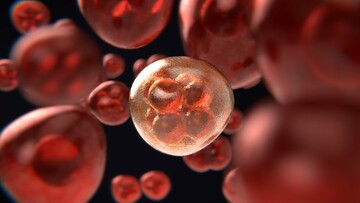What is mitosis?

Mitosis is a type of cell division that produces two identical daughter cells.

Mitosis is a type of cell division that produces two identical daughter cells.
Mitosis is a process that cells use to make copies of themselves. It's how our bodies grow and repair themselves. Mitosis happens in four stages: prophase, metaphase, anaphase, and telophase.
- Prophase: In prophase, the chromosomes in the cell start to coil up. The nuclear envelope breaks down, and the chromosomes become visible.
- Metaphase: In metaphase, the chromosomes line up in the middle of the cell.
- Anaphase: In anaphase, the chromosomes split apart and move to opposite ends of the cell.
- Telophase: In telophase, the chromosomes uncoil, and a new nuclear envelope forms around each set of chromosomes. The cell then divides into two new cells.
Mitosis is a very important process. It's how our bodies grow and repair themselves. For example, when you cut your skin, mitosis helps your body make new skin cells to heal the cut. Mitosis also helps our bodies grow taller. As we get older, our cells divide to make new cells. This is how we grow taller.
Here is a concrete example of mitosis:
Imagine a plant cell. The plant cell has a nucleus, which contains the cell's DNA. The DNA is like a blueprint that tells the cell how to grow and function. During mitosis, the DNA in the nucleus is copied. This means that each new cell will have the same DNA as the original cell.
Once the DNA is copied, the cell divides into two new cells. The new cells are identical to the original cell. This is how plants grow and repair themselves.
What is meiosis?
Meiosis is a process that cells use to make special cells called sex cells. Sex cells, such as sperm and eggs, come together to make a baby. Meiosis happens in two stages: meiosis I and meiosis II.
Meiosis I: In meiosis I, the chromosomes in the cell line up and pair with their matching partner chromosome. Then, they swap pieces of themselves to create new combinations of genes. This helps make each sex cell unique.
Meiosis II: In meiosis II, the paired chromosomes separate, and the cell divides into four new cells. These new cells only have half the number of chromosomes as regular body cells. This is important because when the sperm and egg come together, they will have the right amount of chromosomes to create a new baby.
An example of meiosis is like mixing up puzzle pieces. Imagine you have two sets of puzzle pieces - one set from your mom and one set from your dad. During meiosis, the pieces from both sets mix together and create a new puzzle piece. This new puzzle piece is what makes you unique and different from your parents.
Meiosis is a crucial process because it helps create diversity in the world. It's what makes each person special and different from one another. Without meiosis, everyone would be exactly the same!

Mitosis is a type of cell division that produces two identical daughter cells.